#Kryphioparma
Explore tagged Tumblr posts
Text
Triassic Double Feature
Just weeks ago I remissed the lack of new croc taxa, seems I spoke to soon because they are being pumped out like crazy right now. For simplicity, I will cover two of the recent sorta-crocs together as neither are super extensive and they match in overall time.
These two new genera are the aetosaur Kryphioparma and the phytosaur Jupijkam. Pictured below the fossils of both with reconstructions of close relatives (art by Brian Engh and Gabriel Ugueto).
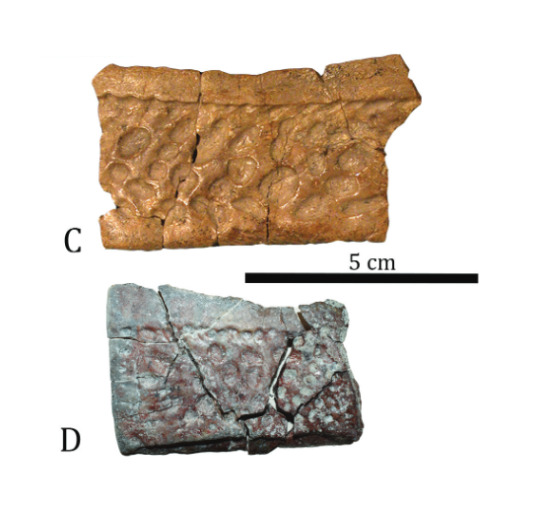

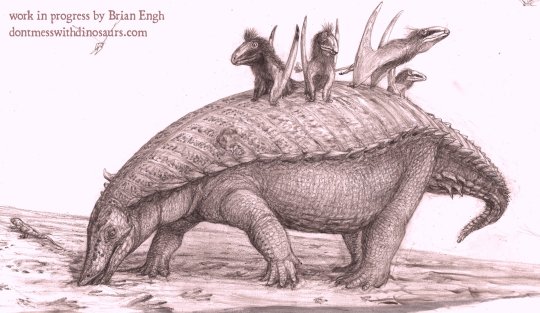

I'll start with Kryphioparma, which I wager is the less interesting of the two. Kryphioparma was an aetosaur, which are effectively early pseudosuchians that evolved a body type very similar to what nodosaurs did later. Heavily armored, sometimes with prominent spikes and herbivorous.
Kryphioparma is only known from four isolated and incomplete osteoderms, and though these are actually diagnostic and highly distinct, it does mean there's not super much to say. Hell, the scientific name literally means "mysterious shield" in reference to how little we know.
Regardless, scientists did determine two things. 1) It's a typothoracine aetosaur, narrowing down its placement to one of the two main branches. This means its closer related to Typothorax (with its armored cloaca) than to Desmatosuchus (with its shoulder spikes). 2) The second thing we know is that it wasn't alone. No, the localities that yielded its bones (Placerias Quarry and Thunderstorm Ridge) actually preserve a highly diverse aetosaur fauna, including Calypsosuchus, Tecovasuchus and two species of Desmatosuchus. All images by Jeff Martz.

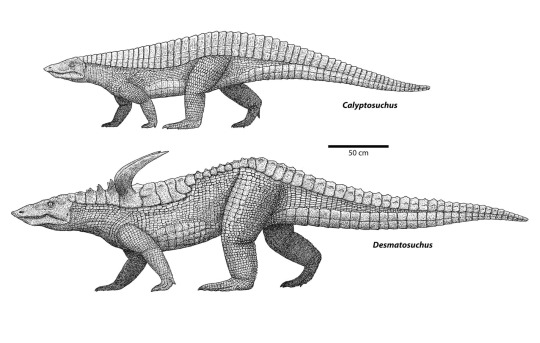
Now the arguably more exciting find is that of Jupijkam, a type of phytosaur, which are archosaurs superficially resembling today's crocodiles. Now when I grew up, phytosaurs used to be considered to be entirely unrelated to crocs, being a type of archosaur believed to have diverged prior to the bird-croc split. However, it would appear that recent studies suggest that they could actually be true croc-line archosaurs, potentially being the earliest diverging group of Pseudosuchian.
Jupijkam is from the Rhaetian-Norian Blomidon Formation of Novia Scotia, Canada. This not only makes it one of the youngest, but also one of the northern-most known phytosaurs to date. It's scientific name, Jupijkam, is actually derived from the name given by the local Mi’kmaq people to their version of the horned serpent.
How Jupijkam is related to other phytosaurs is a bit wonky. Now generally, its recovered as a mystriosuchine, which isn't exactly a surprise given that most phytosaurs fall into this category. It's placement however shifts ever so slightly depending on the precise methods and characters used. 2/4 times it was found to be most closely related to Rutiodon (the phytosaur shown at the very start), once alongside the Indian Volcanosuchus and once to its exclusion. One tree simply results in a big polytomy which isn't really helpful, and one time it was found as a much more derived form related to Mystriosuchus. Whatever the case, additional finds both of other phytosaurs and Jupijkam specifically might clarify this in the future. Currently however, it seems that this form is not related to all the other American species of its time, suggesting it held out till the late Triassic independently. Which is pretty neat. Below you can see a comparisson between Jupijkam and some other slender-snouted phytosaurs, courtesy of Brownstein 2023. A is Jupijkam, B is Rutiodon and C is Machaeroprosopus

Really that wraps things up already, two new genera, both Triassic, both (potentially) early Pseudosuchians. A little bit out of my usual focus but very interesting none the less. Definitely gotta make another post soon since they just dropped yet another new one (a metriorhynchid), but I gotta read that paper first. Speaking of which A new aetosaur (Archosauria: Pseudosuchia) from the upper Blue Mesa Member (Adamanian: Early–Mid Norian) of the Late Triassic Chinle Formation, northern Arizona, USA, and a review of the paratypothoracin Tecovasuchus across the southwestern USA (escholarship.org) A late-surviving phytosaur from the northern Atlantic rift reveals climate constraints on Triassic reptile biogeography | BMC Ecology and Evolution | Full Text (biomedcentral.com) plus the respective Wikipedia pages Kryphioparma - Wikipedia Jupijkam - Wikipedia
#pseudosuchia#phytosaur#aetosaur#croc#palaeoblr#paleontology#prehistory#triassic#chinle formation#Kryphioparma#Jupijkam#long post#science#reptiles
40 notes
·
View notes
Text
A new aetosaur (Archosauria: Pseudosuchia) from the upper Blue Mesa Member (Adamanian: Early–Mid Norian) of the Late Triassic Chinle Formation, northern Arizona, USA, and a review of the paratypothoracin Tecovasuchus across the southwestern USA
Published July 2023
A new aetosaur, Kryphioparma caerula, from the upper Blue Mesa Member of the Chinle Formation is described based on fragmentary remains.

Fragmentary osteoderms from Kryphioparma caerula holotype

Kryphioparma caerula osteoderm
Source:
7 notes
·
View notes
Text
Fossil Crocs of 2023
2023 has been a year with its ups and downs, but one consistent thing has been its fossil crocs at least, giving us another interesting variety of species and genera not known before. Like last year, I'll go down each of them (including phytosaurs) and give you some key notes. And since I've done my best to make individual posts for them I'll link those when available. I'll also try to give translations where possible, but do note that sometimes I might switch around a word due to it just sounding awkward otherwise.
Scolotosuchus
Starting us off is Scolotosuchus basileus ("royal scythian crocodile"), a basal, rauisuchian-like animal from the early stages of the Triassic. An animal roughly 3 meters long, it is primarily known from vertebrae and some other material, which however does have interesting implications. Based on the anatomy of the vertebrae, it has been speculated that Scolotosuchus performed a lot of rapid movement of the neck, presumably while hunting. Furthermore, it might be that Scolotosuchus lacked osteoderms, instead having developed a bracing system for its body much more like that of dinosaurs and mammals. Artwork by @knuppitalism-with-ue (he'll pop up quite a lot)
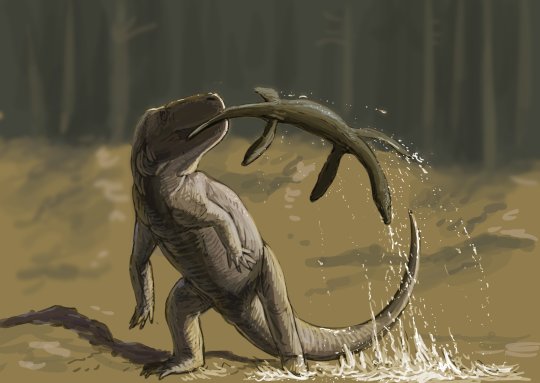
Colossosuchus
Fast forward to the Late Triassic, the hayday of early Pseudosuchians, and we find our first phytosaur of the list. Colossosuchus techniensis ("colossal crocodile of the Indian Institute of Technology") was an enormous animal from India's Tiki Formation. This one is known from undisputably better material, perhaps some of the best on this list as we have an entire bone bed of these guys, possibly representing a mass death site. Size estimates of the large specimens generally range from 6 to 9 meters in length, also making it the largest animal of this list, with the authors favoring an estimated 8 meters for the largest individual. Of course this is all subject to change, as we don't know the precise proportions (the downside of a bone bed is that all the bones are kinda jumbled together and god knows what belongs to what). Artwork by Joschua Knüppe again, a female being courted by an overconfident and confused Volcanosuchus (told you so)

Kryphioparma
Ok I won't bother you with this one too much. Kryphioparma caerula ("blue mysterious shield") is an aetosaur from the Late Triassic Chinle Formation of Arizona. Now aetosaurs are cool of course, but the thing is that Kryphioparma is known from exclusively osteoderms, their large armour plates. While thats valid, its also not really exciting (as you could have guessed from the absolute lack of artwork). Best I can say is that it coexisted with a bunch of other aetosaurs, which surely would have been a sight to see back in the day.
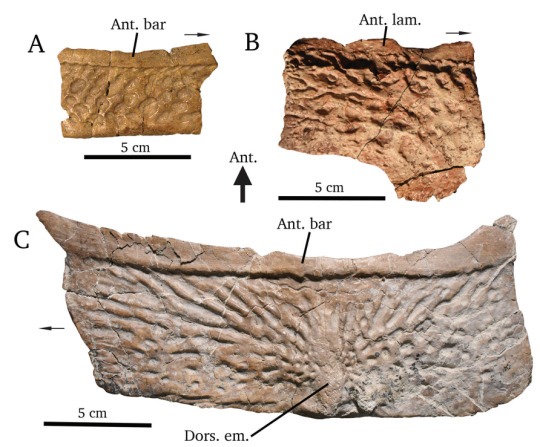
Venkatasuchus
Now Venkatasuchus armatum ("Venkata's armoured crocodile") is in a similar boat. This Indian aetosaur too is only known from osteoderms, tho at least a lot more of them that were found together, meaning we got a much better idea of its shape. There are some interesting implications it has on paleogeography and how different animal groups spread across Pangea, but that's probably beyond the scope of this post. There is at least some art of it tho, including one piece by Joschua featuring Jaklapallisaurus, an early sauropodomorph.
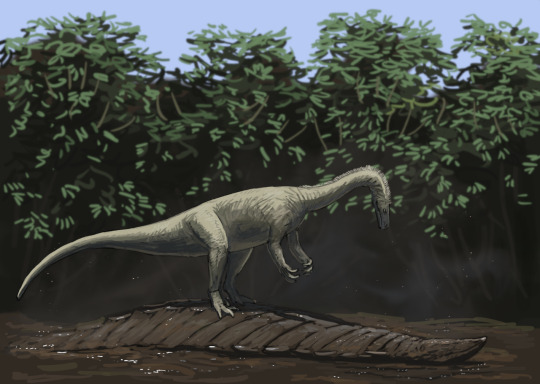
Mystriosuchus alleroq
Now we got our first new species of a preexisting genus. While I did my best to make posts on new genera, which typically went hand in hand with their respective wikipedia pages, species are a different matter since they'd require me to overhaul and research the whole genus. Which for Mystriosuchus would go all the way back to 1896.
Anyhow, Mystriosuchus alleroq ("jawbone spoon crocodile") is the newest in a long line of Mystriosuchus species and has been recovered from western Greenland of all places. Like Colossosuchus it is known from multiple individuals, at least four in fact, And like Venkatasuchus, it appears to have wideraning implications for the spread of archosaurs during the Triassic. Oh look its Josch's art again, neat.
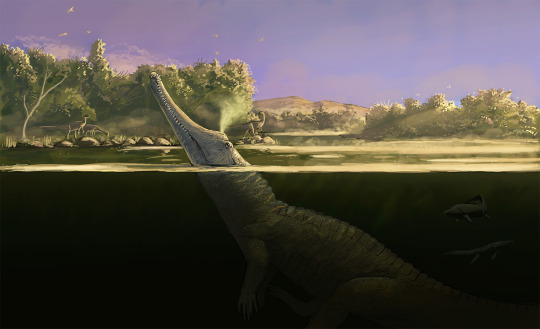
Jupijkam
The final phytosaur and the final Triassic taxon of the year, Jupijkam paleofluvialis ("horned serpent of ancient rivers") was recovered from Nova Scotia Canada and represents one of the northernmost phytosaurs (alongside obviously our friend Mystriosuchus alleroq above). It is far less complete than the other phytosaurs I covered so far, but still nothing to scoff at. It's also one of the youngest known phytosaurs, possibly having lived during the last stage of the Triassic. There's no art but here's an image of its snout from the original paper.

Turnersuchus
And with this we have reached the Jurassic and somewhat of a double feature. Ordering these via chronology makes this almost like storytelling. Turnersuchus hingleyae ("Hingley's and Turner's crocodile") is the oldest and basalmost named thalattosuchian, a group of crocodylomorphs that took to the seas. As such it shows a mosaic of features, already having begun to reduce its limbs, having a moderately long snout and still bearing osteoderms, which some of its descendents would come to lose. Turnersuchus dates to the Pliensbachian, a stage of the early Jurassic, tho the paper mentions how its not likely to hold its title as oldest member of its group for long as even older material has been discovered and is awaiting publication. Artwork by Júlia d’Oliveira and Joschua Knüppe

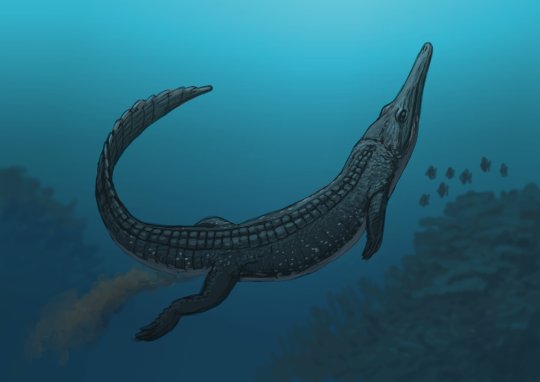
Torvoneustes jurensis
While Turnersuchus gives us a glimpse at what the earliest thalattosuchians were like, Torvoneustes jurensis ("savage swimmer of the Jura Mountains") represents them at one of their most derived. At 4 meters long, it must have been an impressive creature, entirely smooth and lacking osteoderms, highly reduced arms and a tail fluke to boot. There are some interesting features, as unlike other species of Torvoneustes, this one does not appear to have been as durophagous, instead appearing to be more of a generalist. It's the last Jurassic croc of the year and practically lived at the opposite end of this time period relative to our previous thalattosuchian, during the Kimmeridgian. Artwork by Sophie De Sousa Oliveira, not to be confused with Jùlia who drew Turnersuchus.
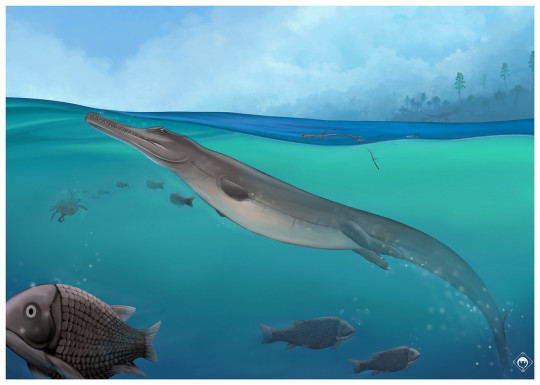
Comahuesuchus bonapartei
From marine to terrestrial, Comahuesuchus bonapartei is a member of the Notosuchia, land-dwelling cousins to the Neosuchia. This new species is known from the Cretaceous of Argentina and was described on the basis of a lower jaw, which differs from the previously described species of Comahuesuchus by the fact that the teeth are situated in individual sockets. Its jaws were short and wide, being described as U-shaped, giving it a somewhat pug-nosed appearance. In case you're wondering why I don't have the translation of the name thats because I can't access Bonaparte's first paper, so all I can say is that the new species is named after famed Argentinian paleontologist Jóse Fernando Bonaparte. Artwork by I mean you probably guessed it, its Josch again.
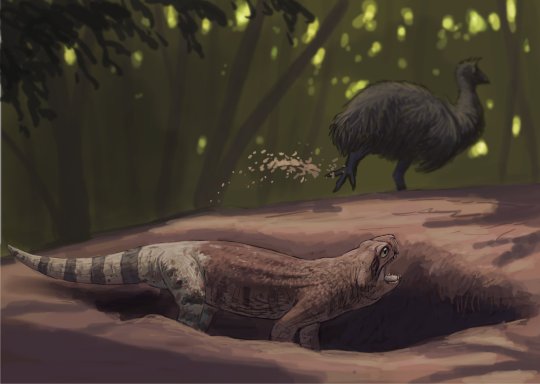
Aphaurosuchus kaiju
I have some mixed feelings on Aphaurosuchus kaiju ("powerless kaiju crocodile"), not just because I have to rewrite its genus wikipedia page that I am no longer happy with. No, Aphaurosuchus is a great genus in my opinion, given the complete nature of the holotype. But I do think that the species name of this second form is a bit of an exaggeration, seeing as it is to my knowledge not that exceptionally big. So why name it kaiju other than to sound cool? I also think it just kinda becoms funny when you consider the meaning of the genus name. Anyhow, it does look pretty mean, but thats to be expected from a baurusuchid. It lived during the Late Cretaceous in Brazil and the phylogenetic analysis that accompanied its description had some interesting implications that I'm curious to see tackled in the future. Other than that it's just another baurusuchid from a place crawling with baurusuchids, which tbh is pretty cool itself but doesn't really help make it stand out. Arwork by Paula Zeinner
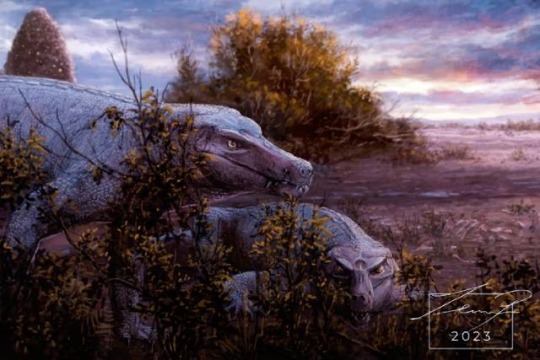
Dentaneosuchus
It is the middle Eocene. France is entirely occupied by mammals. Well, not entirely... One indomitable reptile still holds out against the invaders. Yes, I am of course talking about Dentaneosuchus ("frightfull crocodile"), the titan of the Eocene, the terror of the jungle. Easily among the most exciting finds, this animal was an enormous sebecid previously thought to be a member of the genus Iberosuchus, but recent research not only shows its distinct but enormous. With a lower jaw around 90 cm long, it rivals even the famed Barinasuchus of Miocene South America. The total body lenght is of course a matter of debate given how little we know about sebecid proportions, with the paper lowballing it at 3 to 4 meters and I personally recovering something more akin to 5 meters. Regardless of the specifics, this would make it easily one of the top predators of its time, tho sadly this was not meant to last. It was among the last non-mammalian apex predators of Europe, before climate change and competition from mammals eventually drove them to extinction. Arwork by Joschua Knüppe and @mariolanzas

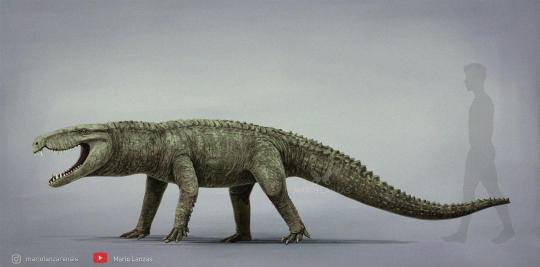
Baru iylwenpeny
Our last three entries were all members of the Notosuchia, the terrestrial crocodiles that existed from the Jurassic to the Miocene, so lets jump to the other major group of the time, the Neosuchians, specifically their most recent branch, the Crocodilians. Yes finally we are getting to crocs in the stricter sense.
Baru iylwenpeny ("divine crocodile thats good at hunting") is an animal we also knew for a while under the informal name Alcoota Baru based on where it was found. This year I spent a lot of time writing in the Mekosuchinae, Australasian crocodiles of the Cenozoic and just when I had finished the page for Baru, this guy got published. It's the largest, most robust and most recent member of the genus. Good at hunting is a good choice for the species name, as this animal was over 4 meters long with a head commonly likened to a cleaver and a hunting style speculated to consist of inflicting a lot of trauma on its prey with its massive teeth. I could gush about Baru for ages, but thats the important parts. It lived in central Australia during the Miocene only 8 million years ago. Artwork by the incredible @manusuchus
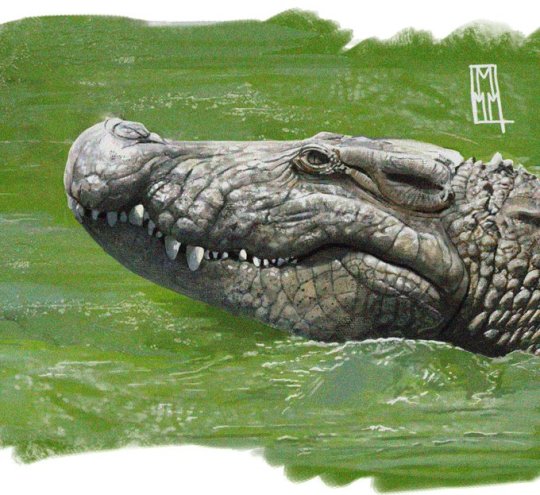
Antecrocodylus
Now for the last crocodilian described this year and one I remised to make a dedicated post for due to time constraints (I had a busy few months). Antecrocodylus chiangmuanensis ("before Crocodylus from Chiang Muan") is a close relative of the modern dwarf and true crocodiles from the Miocene of Thailand. It is only known from the back of the skull and an associated lower jaw, but it serves to highlight how little we know about the crocodiless of eastern Asia during the Miocene, which is a shame given that this region is crucial to deciphering where true crocodiles originated.
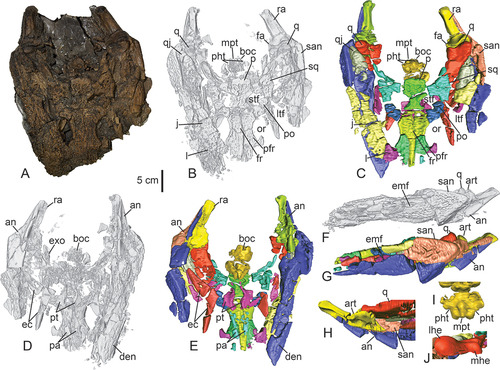
Alligator munensis
And our final taxon is Alligator munensis ("Mun river alligator"), which, obviously, is a member of the modern genus Alligator and thus most closely related to the still extant Chinese and American Alligator. Likely having been split from its Chinese relatives when the Tibetan plateau was lifted up, this species lived during the middle Pleistocene in Thailand and may have survived until the Holocene. It's head was short and robust and its teeth globular, which could indicate that it fed on hard-shelled prey like clams and snails. It was also small, likely not much bigger than 1.5 meters. Artwork by Joschua Knüppe


And that should be all of them, all new species and genera of Pseudosuchians described this past year. It's once again been fun to look back and I hope that you find them just as interesting as I do. Lets hope that 2024 will bring equally fascinating discoveries.
#alligator munensis#alligator#croc#crocodile#pseudosuchia#notosuchia#crocodilia#crocodylus#antecrocodylus#thalattosuchia#torvoneustes#paleontologoy#torvoneustes jurensis#turnersuchus#comahuesuchus#aphaurosuchus#aphaurosuchus kaiju#dentaneosuchus#jupijkam#colossosuchus#palaeoblr#prehistory#kryphioparma#venkatasuchus#mystriosuchus#scolotosuchus#baru#baru iylwenpeny#science
270 notes
·
View notes
Text
Garzapelta: The Convergent Aetosaur
Our second pseudosuchian of 2024 couldn't be any more different from the first. While the first genus named this year was Varanosuchus, a small, agile atoposaurid from the Cretaceous, our second genus is Garzapelta (Garza County Shield), a large lumbering aetosaur, basically the ankylosaur of the Triassic.
If you remember the two posts on aetosaurs I did last year, you probably remember how osteoderms are super diagnostic for these guys and how the material doesn't need to be all that exciting to represent a new genus. In the case of Garzapelta its kind of an intermediate. It's better than the handfull of osteoderms we got for Venkatasuchus and Kryphioparma but its still mostly just osteoderms and some ribs (and a single toe bone).

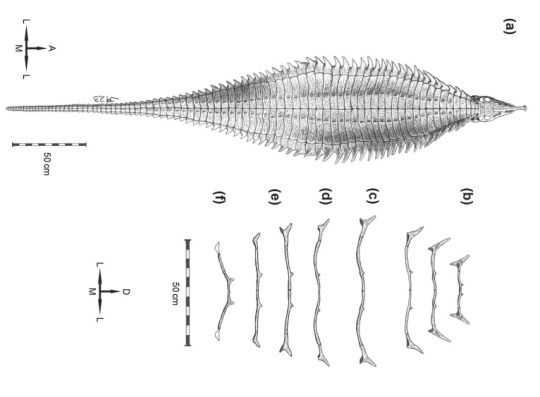
Now the thing that stands out about Garzapelta is the specific combination of characters displayed by the osteoderms. So if you take a step back and look at aetosaurs as a whole, you'll see two big groups that split off from one another. The stagonolepoids, which eventually gave rise to the overly spiky desmatosuchines, and the aetosaurines, which gave rise to some really wide paratypothoracines. Shown below Desmatosuchus and Paratypothorax (not to scale), taken from Martz et al. 2013 and Heckert et al. 2010
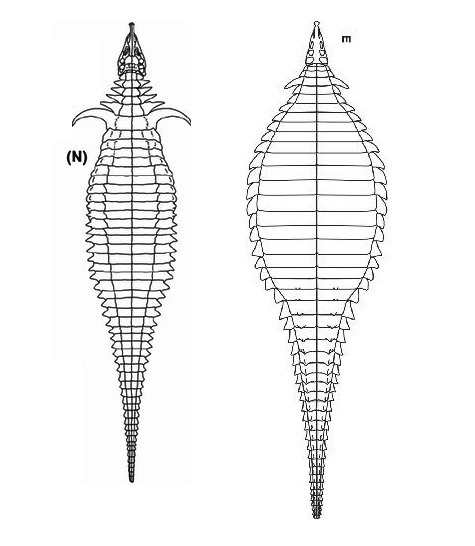
But this doesn't yet say why Garzapelta is special. Well you see. We got both the paramedian osteoderms (the central two rows) and the lateral osteoderms (those spikes on the side). Now, the lateral osteoderms are morphologically really similar to those of desmatosuchines, HOWEVER, the paramedian osteoderms more closely resemble those of paratypothoracines. This is so extreme that when writing the paper, Reyes and colleagues did separate phylogenetic analysis for both osteoderm types. And as you might have guessed, when just looking at the laterals it was recovered as a desmatosuchine, but when looking at the paramedians it was recovered as a paratypothoracine (or rather something close to said groups). And when looking at both at the same time....well still a desmatosuchine.
Ironically, despite this, the authors don't think it was a desmatosuchine. Instead, the way the lateral and paramedian osteoderms connect is way more similar to paratypothoracines and ultimately the authors argue that its way more likely that the shape of the lateral osteoderms is the thing that evolved convergently. This whole situation does however highlight a major thing. Current datasets aren't really ready to deal with convergence like this.
And thats all I got to say about this one. Not as extensive as little Varanosuchus I know, but its surprisingly much given its just a bunch of osteoderms and not much in terms of skull remains or anything like that.
64 notes
·
View notes
Text
Venkatasuchus: Aetosaur from India
Once more I come bearing croc news. For the second time this year we are getting a new type of aetosaur, you know, those weird stem-crocodiles that somewhat converged with ankylosaurs? Yeah those guys. Much like Kryphioparma from just a few months ago, this new genus Venkatasuchus is a member of the Typothoracinae and known only from osteoderms. Thankfully, in the case of Venkatasuchus a lot more of them at least.

I mean sure 8 associated osteoderms plus the connected lateral elements is not that much, but it sure beats the few remains of Kryphioparma.
Anyhow, Venkatasuchus is from the middle Norian to Rhaetian stages of the Triassic of India, more specifically the Lower Dharmaram Formation in the east of the subcontinent. This is actually quite significant as aetosaurs are generally rare in Gondwanan parts of the world and the Dharmaram Formation actually has two: Venkatasuchus and an as of yet undescribed desmatosuchine. Furthermore, the formation actually represents a melting pot of Laurasian and Gondwanan fauna. The aetosaurs and phytosaurs are of Laurasian origin, but the dinosaurs of the formation are Gondwanan lineages.


Much to my surprise, there is ALREADY an illustration of this guy online courtesy of Scott Reid on Twitter, fantastic art, love how he cheekily hides the head and focuses on the armour.
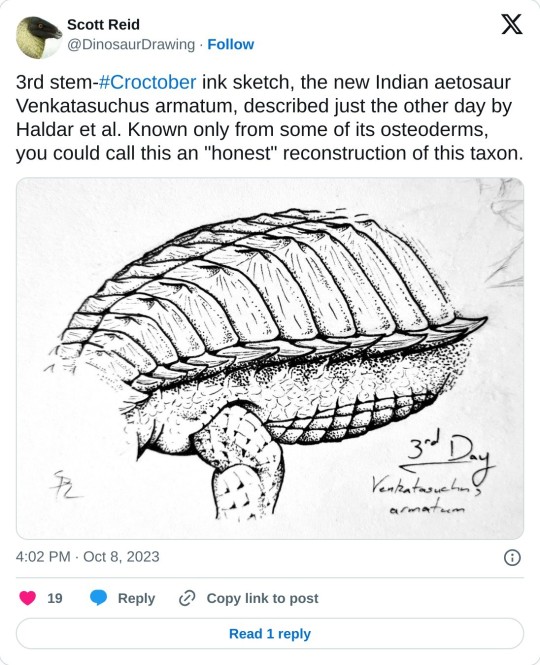
Venkatasuchus - Wikipedia
Of course I jumped at the opportunity to write its wiki page, so far I do believe I managed to cover every new genus published this year.
#aetosaur#aetosauria#aetosaurinae#typothoracinae#paratypothoracini#venkatasuchus#triassic#india#palaeoblr#paleontology#prehistory#pseudosuchia#stem croc#croctober
140 notes
·
View notes